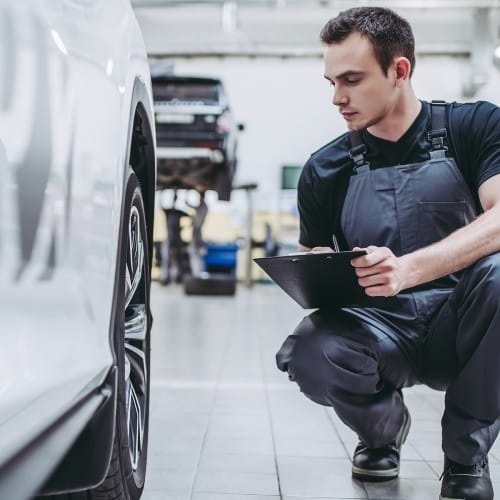Tire Pressure 101: Everything You Need to Know
Of all the maintenance owners perform on their vehicles, maintaining the correct tire pressure is without a doubt one of the most important. Proper tire pressure not only provides optimum ride quality, it also keeps you and your loved ones safer and saves money in the long run. Here’s a look at everything you need to know about tire pressure.
What is the Correct Tire Pressure?
Manufacturers measure tire pressure in pounds per square inch (PSI). Recommended tire pressure varies from vehicle to vehicle. Also, ignore the maximum PSI number on your tire’s sidewall. That number represents the highest “cold” inflation pressure that the tire can handle. Instead, check the owner’s manual or the sticker inside the driver’s door for the ideal tire pressure for your vehicle. And be sure to check the numbers for all four, as occasionally, automakers will designate a different pressure for the front and rear sets. Do not overinflate in an attempt to improve fuel economy or underinflate trying for softer ride quality. Either of these conditions could lead to other issues, as you’ll read shortly.
How Often Should I Check My Car’s Tire Pressure?

Regularly checking your tire pressure and inflating your tires to the recommended level for your vehicle is an easy way to ensure that your car is performing at its best and that you’re getting the most out of your tires. Don’t wait for a warning from the Tire Pressure Monitoring System to tell you something is wrong. That system only kicks in when one of your tires drops to seventy-five percent of the manufacturer’s recommended pressure. If one of your tires has a slow leak, you may have been driving around for months on an underinflated tire. And, while tire pressure fluctuates the most during winter – cold temperatures can cause as much as a five pounds-per-square-inch (PSI) drop during cold months – it’s probably best to stick to a once-per-month schedule, if possible. That way, if your tire does leak, you’re likely to catch it much sooner than on a more infrequent schedule. If you’re lucky enough to have a vehicle that displays each tire’s pressure on its dashboard, then there’s no reason not to check the pressure weekly.
What Can Happen if I Drive with Underinflated Tires?
When your tires are underinflated, they can overheat and wear down faster, which can lead to blowouts or other tire failures. Underinflated tires will make too much contact with the road and lead to increased friction, which in turn may cause overheating and increase the possibility of a blowout. Tires not completely inflated will also result in premature wear and tear on the tire itself, as well as the car’s suspension and chassis. Driving on under-inflated tires can also hamper your ability to stop, make evasive maneuvers, and take curves smoothly. As if that’s not enough, under-inflated tires also lead to increased rolling resistance and lower fuel economy.
What Can Happen if I Drive with Overinflated Tires?
Overinflating your tires leads to almost the same problems as underinflating but in a different way. Overinflated tires will wear faster in the center of the tire than at the edges. Believe it or not, overinflation can cause tires to wear twice as fast as normal. And, with less tire area meeting the road, you are more susceptible to losing traction, especially on wet or slippery pavement. Overinflation also creates a harsher ride, and puts additional stress on your vehicle’s suspension, just as underinflating does.
So, pick a day each month, the first, the last, or some other day that you will remember, and check your car’s tire pressure regularly. This quick process will save you money, enhance ride quality, and most importantly, keep you and your loved ones safer.

 Find a Location Near You
Find a Location Near You